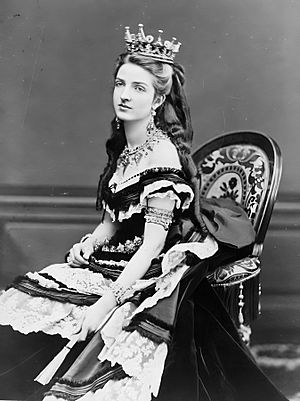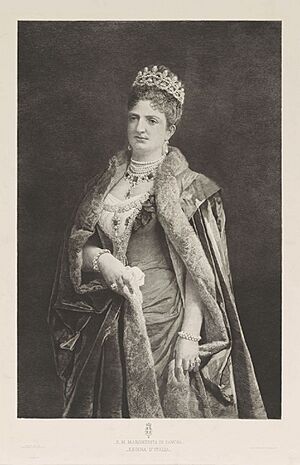Margherita of Savoy facts for kids
Quick facts for kids Margherita of Savoy |
|||||
|---|---|---|---|---|---|

Margherita in the 1870s
|
|||||
| Queen consort of Italy | |||||
| Tenure | 9 January 1878 – 29 July 1900 | ||||
| Born | 20 November 1851 Palazzo Chiablese, Turin, Kingdom of Sardinia |
||||
| Died | 4 January 1926 (aged 74) Bordighera, Italy |
||||
| Burial | Pantheon, Rome | ||||
| Spouse | Umberto I of Italy | ||||
| Issue | Victor Emmanuel III of Italy | ||||
|
|||||
| House | Savoy-Genoa | ||||
| Father | Prince Ferdinand, Duke of Genoa | ||||
| Mother | Princess Elisabeth of Saxony | ||||
Margherita of Savoy (born November 20, 1851 – died January 4, 1926) was the Queen of Italy. She became queen by marrying Umberto I. Her full name was Margherita Maria Teresa Giovanna.
Contents
Life of Queen Margherita
Her Early Life and Education
Margherita was born to Prince Ferdinand, Duke of Genoa and Princess Elisabeth of Saxony. Her father passed away in 1855. Her mother later married again.
Margherita received a very good education for a princess of her time. She was taught by Countess Clelia Monticelli di Casalrosso and her governess, Rosa Arbesser. She was known for being very curious and smart. People described her as sensitive and proud, with a strong will. She was also charming when she wanted to be. Margherita was tall and had blonde hair.
At first, there was talk of her marrying Prince Charles of Romania. But in 1867, it was decided she would marry her cousin, Umberto. He was the heir to the Italian throne.
Becoming Crown Princess
Margherita signed her wedding agreement with her cousin, Umberto, on April 21, 1868. The next day, they had two wedding ceremonies. After their wedding, the royal couple moved to Naples. On November 11, 1869, Margherita gave birth to their only child, Victor Emmanuel III of Italy. He was born in Capodimonte, Naples.
Margherita and Umberto worked well together as a team, even if their personal relationship wasn't perfect. Umberto often relied on her for political advice.
Margherita believed in a strong monarchy, where the ruler looked after the people. Because Italy didn't have a queen at the time, Margherita became the most important lady in Italy after her marriage. She had many duties to represent the new royal family of a united Italy. Her job was to make the royal family popular across the country.
She was very good at this role. She knew how to say and do the right things to excite people. When she traveled through Italy, she wore local clothes. She showed interest in local customs and traditions. This made her so popular that she became even more liked than her husband.
In January 1871, Italy became fully united, and Rome was named the capital. Margherita and Umberto moved to Rome. There, Margherita continued her work. She made her royal receptions a popular place for Roman high society. She helped bring together different groups who had been against Italy's unification. Her gatherings became famous across Europe.
As Queen of Italy
Margherita became Queen of Italy on January 9, 1878. This happened when Umberto became king. That year was difficult for Italy. There was an attempt to harm the new king. Umberto reportedly asked Margherita for her political advice during this time.
After the attack on the king in November 1878, Margherita worked even harder. She wanted to make the crown stronger and build loyalty to the monarchy. She did this by gathering supporters and making important connections. Her close friends, Paola Pes di Villamarina and Emanuele Pes di Villamarina, helped her a lot.
As queen, Margherita worked to protect the monarchy from groups like republicans and socialists. She brought together a group of thinkers and artists. This group was known as the "Circolo della regina" (Circle of the Queen). They met at her famous literary gatherings called "giovedì della regina" (Queen's Thursdays). She supported many artists and writers. She also founded cultural places, like the Società del Quartetto and the Casa di Dante.
Queen Margherita also showed loyalty to the monarchy through charity work. She often visited hospitals, schools, and places for children and the blind. She helped these places and even started the first library for the blind in Florence in 1892. Her work was very effective. By the 1880s, she was seen as a popular symbol of the Italian monarchy. Poets, authors, and the press praised her as a symbol of good morals.
Queen Margherita was very close to her son. She made their relationship even stronger after his wedding. She was also involved in state matters. She saw democracy as a possible threat to the monarchy. She supported Francesco Crispi in his actions against parliament.
As a nationalist, she supported the First Italo-Ethiopian War in 1896. This was different from Umberto, who was unsure about it. She was a key figure among conservative groups. She supported strong actions against rioters in Milan in 1898. This led to the Bava Beccaris massacre.
On August 18, 1893, Margherita climbed a mountain peak called Punta Gnifetti. It is part of the Monte Rosa mountains on the border between Switzerland and Italy. She was there for the opening of a mountain hut named after her. At 4,554 meters (14,941 feet), the "Capanna Regina Margherita" (Margherita Hut) is still the highest hut in Europe. Margherita later became the Honorary President of the Ladies' Alpine Club.
Life as Queen Dowager
King Umberto I was killed on July 29, 1900, by an anarchist. He had survived two other attacks before. As the widow of a murdered king, Margherita received a lot of sympathy. This created a strong image of her as a grieving widow. She used this image to help the monarchy's reputation.
After Umberto's death, Margherita stepped back a bit. She allowed her daughter-in-law, the new queen, to take the lead. This was important for the royal system she believed in. However, she did not stop her public life. She remained a strong public figure. She continued to visit hospitals and churches until her death. She saw these as her royal duties.
She did not like her son, the new king, being too accepting of democracy. She saw it as a type of socialist monarchy. She worked to keep royal traditions strong against democratic ideas. Her son did not want her to have influence in state matters. But she stayed involved in politics through her connections. She remained a political figure. Unlike most nationalists, Margherita was against World War I. During the war, she turned one of her homes into a hospital. She also worked actively with the Red Cross.
After World War I, Margherita worried about a socialist revolution and the end of the monarchy. Because of her nationalism and conservative views, she supported Fascism under Benito Mussolini. She felt a personal respect for Mussolini. In October 1922, four important Fascist leaders visited her. They paid their respects before the March on Rome.
Queen Margherita's Legacy
Many places and things were named after Queen Margherita:
- In 1879, the town of Margherita di Savoia, Apulia in Italy was named after her.
- In 1881, the mining town of Margherita, Assam in India was named after her.
- Also in 1881, a large stained-glass window of her was made by Studio Moretti Caselli. It was shown around Italy and Europe.
- According to a popular story, the famous Margherita pizza was named after her in 1889. Its red tomatoes, green basil, and white cheese represent the Italian flag.
- A large warship, a pre-dreadnought battleship, was named in her honor. It was started in 1898 and launched in 1901.
- In 1906, her nephew, Prince Luigi Amedeo, Duke of the Abruzzi, climbed the highest peak of Mount Stanley. This is the third highest mountain in Africa. He named it Margherita Peak to honor her.
- In 2011, some of the Queen's jewelry was sold at an auction.
Images for kids
See also
 In Spanish: Margarita Teresa de Saboya para niños
In Spanish: Margarita Teresa de Saboya para niños



